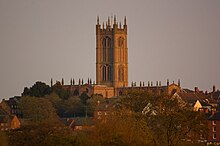St Laurence's Church, Ludlow
| St Laurence's Church, Ludlow | |
|---|---|
 |
|
| Country | United Kingdom |
| Denomination | Church of England |
| Churchmanship | Liberal Catholic |
| Website | stlaurences.org.uk |
| History | |
| Dedication | St. Laurence |
| Administration | |
| Parish | Ludlow |
| Archdeaconry | Ludlow |
| Diocese | Hereford |
| Province | Canterbury |
| Clergy | |
| Rector | Vacant |
| Laity | |
| Organist/Director of music | Shaun Ward |
| Organist(s) | Roger Judd |
Coordinates: 52°22′6″N 2°43′7″W / 52.36833°N 2.71861°W
St Laurence's Church, Ludlow is a parish church in the Church of England in Ludlow.
The church is a member of the Greater Churches Group and is the largest parish church in Shropshire. It was one of only 18 churches given a five-star rating in England's Thousand Greatest Churches by Simon Jenkins (1999) and is described as the "cathedral of the Marches". It is the 13th most popular free visitor attraction in the West Midlands, with 70,000 visitors per year.
The parish church was established as a place of worship in association with the founding of Ludlow by the Normans in the late 11th century. It is situated atop the hill around which the medieval town developed. The church was rebuilt in the year 1199 and has had several later additions and modifications. The tower is 135 feet (41 metres) high and commands expansive views of the town and surrounding countryside. Notable features include an extensive set of misericords in the choir stalls as well as fine stained glass windows.
Original Norman traces were found beneath the south porch, indicating some extant foundations exist from the 11th century AD. After its initial construction the church was expanded and rebuilt in 1199 to accommodate a growing town population. In the late Middle Ages considerable wealth accrued to the town based upon the wool trade. Correspondingly the church underwent several further additions in that era. The major works occurred between 1433 and 1471 with a virtual re-building of the nave, tower and chancel elements. The tower took on a Perpendicular style which was the preferred style of the late 15th century in England. The Saint John's Chapel on the north side was the chapel of the Palmers' Guild, which thrived in the Late Middle Ages. The Palmers' Window within St John's Chapel illustrates the legend of King Edward the Confessor and St John the Evangelist by eight panels and was inspired by the Ludlow Palmers’ 13th century pilgrimage to the Holy Land.
...
Wikipedia
